The Massachusetts Bay Outfall
 |
Outfall Tunnel Schematic
(View Larger
Image)
|

|
| Diffuser Cap:
Initial dilution of the effluent from the new diffusers
is about 1 part treated effluent to 100 parts seawater. |
|
|
|
The outfall for the Deer Island Treatment
Plant is an important part of greater Boston's wastewater management
program. This outfall, which started up in September of 2000,
discharges treated sewage, called effluent, into Massachusetts
Bay instead of into the shallower waters of the Harbor, which
has helped the Harbor's recovery.
The outfall begins with a deep rock
tunnel extending under Massachusetts Bay to a point about 9.5
miles east of Deer Island. Although there was much consensus on
the need for a deep-water discharge of Deer Island effluent, questions
remained about whether Massachusetts and Cape Cod Bays could,
like Boston Harbor, become degraded by sewage effluent. The outfall
site was chosen only after considerable scientific and technical
study and extensive public participation.
CLEANER EFFLUENT
Deer Island effluent quality has been
vastly improved, as a result of source
reduction and secondary treatment. With secondary treatment,
85% of suspended solids, 85% of oxygen consuming material (BOD),
and up to 90% of toxic contaminants are removed from the treated
wastewater, or effluent, before discharge. Disease-causing microorganisms
are also better reduced by secondary treatment because disinfection
is more effective with less solids in the wastewater.
BETTER DILUTION
The initial dilution of the effluent in the bay is about 100 to
1, far greater than the 14-to-1 dilution achieved at the old 30-foot-deep
outfall in Boston Harbor. The impacts of nutrients, which are
not targeted for removal by secondary treatment, should be minimized
by effective dilution in the Bay. The bay discharge is through
a diffuser, which consists of more than fifty pipes that rise
to the seafloor over the last 6,600 feet of the tunnel's length.
Each pipe connects to a diffuser cap which splits the flow into
several streams, each issuing from a small port. More than 400
diffuser ports disperse the effluent into the 100-foot-deep waters
in the Bay, where it is diluted in large volumes of seawater.
To ensure that MWRA's effluent discharge
does not have major effects on Massachusetts Bay, MWRA's discharge
permit requires detailed reporting to both regulators and
the public. In addition, the National Marine Fisheries Service
issued a biological opinion that the outfall, more than 16 miles
away from identified North Atlantic right whale habitat, was not
likely to jeopardize the right whale or other endangered species.
TO LEARN MORE ABOUT THE OUTFALL
The links below from a 1996 report on the outfall are still helpful in understanding the
background of this important project. (These PDF files require free PDF reader
available from Adobe
Systems.)